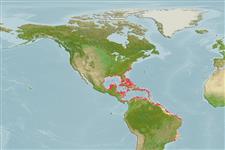Classification / Names
Common names from other countries
Main reference
Size / Weight / Age
Max length : 183 cm TL male/unsexed; (Ref. 26340); max. published weight: 7.8 kg (Ref. 4699)
Length at first maturity
Lm 40.5, range 38 - ? cm
Environment
Marine; reef-associated; oceanodromous (Ref. 51243); depth range 1 - 20 m (Ref. 9710), usually 1 - ? m (Ref. 55288)
Climate / Range
Tropical, preferred 24°C (Ref. 107945); 41°N - 24°S, 99°W - 34°W
Distribution
Short description
Dorsal
spines
(total): 16 - 18;
Dorsal
soft rays
(total): 15-19;
Anal
spines: 0;
Anal
soft rays: 15 - 20;
Vertebrae: 47 - 48. Interpelvic process small and bifid. Lateral line gently curving down toward caudal peduncle. Intestine with 2 folds and 3 limbs. Swim bladder absent. Body covered with small scales. Anterior third of first dorsal fin black. Pelvic fins relatively long. Sides silvery with one long mid-lateral stripe and with several rows of yellow-orange streaks of variable length and small yellow spots above and below the stripe.
IUCN Red List Status (Ref. 115185)
Threat to humans
Reports of ciguatera poisoning (Ref. 9987)
Human uses
Fisheries: minor commercial; gamefish: yes
Tools
Special reports
Download XML
Internet sources
Estimates of some properties based on models
Phylogenetic diversity index
PD50 = 0.5000 many relatives (e.g. carps) 0.5 - 2.0 few relatives (e.g. lungfishes)
Trophic Level
4.5 ±0.4 se; Based on diet studies.
Resilience
Medium, minimum population doubling time 1.4 - 4.4 years (Fec=160,000; assuming tm=2-4)
Vulnerability
High vulnerability (63 of 100)
Price category
